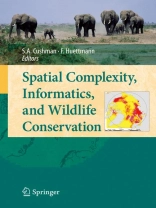As Earth faces the greatest mass extinction in 65 million years, the present is a moment of tremendous foment and emergence in ecological science. With leaps in advances in ecological research and the technical tools available, scientists face the critical task of challenging policymakers and the public to recognize the urgency of our global crisis. This book focuses directly on the interplay between theory, data, and analytical methodology in the rapidly evolving fields of animal ecology, conservation, and management. The mixture of topics of particular current relevance includes landscape ecology, remote sensing, spatial modeling, geostatistics, genomics, and ecological informatics. The greatest interest to the practicing scientist and graduate student will be the synthesis and integration of these topics to provide a composite view of the emerging field of spatial ecological informatics and its applications in research and management.
Inhoudsopgave
Theory and Practice.- Introduction: Ecological Knowledge, Theory and Information in Space and Time.- Space and Time in Ecology: Noise or Fundamental Driver?.- The Problem of Ecological Scaling in Spatially Complex, Nonequilibrium Ecological Systems.- Landscape Ecology: Past, Present, and Future.- The Gradient Paradigm: A Conceptual and Analytical Framework for Landscape Ecology.- Method and Data.- Data on Distribution and Abundance: Monitoring for Research and Management.- Animal Movement Data: GPS Telemetry, Autocorrelation and the Need for Path-Level Analysis.- Using a Random Forest Model and Public Data to Predict the Distribution of Prey for Marine Wildlife Management.- Landscape Genomics: A Brief Perspective.- Spatial Information Management in Wildlife Ecology: Adding Spatially Explicit Behaviour Data to the Equation?.- Critical Remote Sensing Contributions to Spatial Wildlife Ecological Knowledge and Management.- Spatial Data Management Through Metadata: Global Concepts, Formats, Tools and Requirements.- Free Database Availability, Metadata and the Internet: An Example of Two High Latitude Components of the Census of Marine Life.- Components of Spatial Information Management in Wildlife Ecology: Software for Statistical and Modeling Analysis.- Spatial Analysis of Wildlife Distribution and Disease Spread.- Current State of the Art for Statistical Modelling of Species Distributions.- Landscape Genetics.- Examples.- Using Geographical Mapping and Occupancy Modeling to Study the Distribution of the Critically Endangered Leopard (Panthera pardus) Population in Armenia.- Mapping Landscape Resistance to Identify Corridors and Barriers for Elephant Movement in Southern Africa.- Habitat Fragmentation Effects Depend on Complex Interactions Between Population Size and Dispersal Ability: Modeling Influences of Roads, Agriculture and Residential Development Across a Range of Life-History Characteristics.- Linking Cetaceans to Their Environment: Spatial Data Acquisition, Digital Processing and Predictive Modeling for Marine Spatial Planning in the Northwest Atlantic.- Multi-spectral Satellite-Airborne Management of Ice Form Marine Mammals and Their Habitat in the Presence of Climate Change Using a “Hot Spots” Approach.- How Spatial Information Contributes to the Conservation and Management of Biodiversity.- Future and Outlook: Where Are We, and Where Will the Spatial Information Management in Wildlife Ecology Be in 50 Years from Now?.












